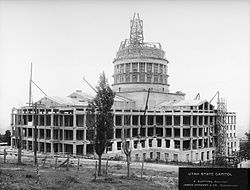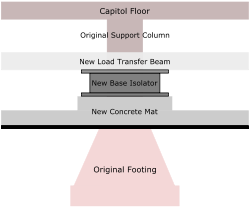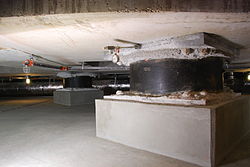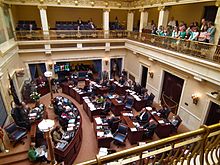Utah State Capitol
| Utah State Capitol Building | |
|---|---|
Richard K.A. Kletting | |
| Website | |
| Utah State Capitol | |
Capitol Building | |
| NRHP reference No. | 78002667[1] |
| Added to NRHP | October 11, 1978 |
The Utah State Capitol is the
The
Early houses of government
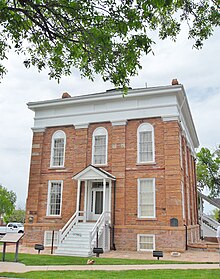
The first
One of the first official acts of the assembly was to designate a

History of the Capitol
Early attempts for a capitol building

As time passed, those smaller buildings became inadequate, so several local leaders and businessmen began to call for a new permanent capitol building. Several of these people requested that Salt Lake City donate about 20 acres (81,000 m2) of land, specifically an area known as Arsenal Hill, just north of the intersection of State and Second North Streets. The City Council of Salt Lake responded by approving a resolution on March 1, 1888, donating the property to the territorial government. A "Capitol Commission" was created to review the design and construction process for the new building. The commission selected Elijah E. Myers, who also designed the Michigan, Texas, and Colorado State Capitols, to design Utah's building. The plans were finished by 1891, but were ultimately rejected because of the $1 million (equivalent to $30.6 million in 2023[5]) cost estimated. Plans for a capitol building were then delayed after the approval of an Enabling Act allowing Utahns to begin plans for statehood.[3] On January 4, 1896 Utah was granted statehood, and the Salt Lake City and County Building was used as a capitol building for the new state.
The design and planning process
By 1909 no capitol had yet been constructed and Governor
After funding was secured, the commission began the design process for the building and grounds. The
Even as questions arose concerning the site location, and work progressed on site plans, the design of the building was begun. The commission decided to hold a design competition, a practice common for many public buildings of that era. A program for the competition was created with design requirements such as required square footage, the desired number of floors, and stipulation to keep the total cost under $2 million (equivalent to $47.6 million in 2023[5]). The program was approved August 30, 1911, and information was sent to architectural firms. Those who were interested responded, and the commission selected 24 firms to compete. Because the compensation was less than expected, several contenders withdrew from the competition, and the commission further reduced the list to eight firms. The final designs for the building were due on January 12, 1912, less than five months after the finalists were selected. After designs were submitted the commission met several times to discuss their selections, and some architects were asked to make presentations. After two months the commission reduced the list of designs to just two, those submitted by Richard K.A. Kletting and Young & Sons, both of Salt Lake City.[3] On March 13, 1912, the commission made its final vote and selected Richard Kletting's design by a vote of four to three.[7] After his appointment as capitol architect, Kletting traveled to several capitals in the eastern United States, including the Kentucky State Capitol which influenced his final designs. His first working plans for the building were due July 15, 1912.
Construction
After Kletting produced more detailed plans, they were made available to contractors interested in
By spring 1913 the foundation and basements walls were in place, and the steel columns and wooden frames for the concrete were being installed. Numerous small shops and offices had been constructed on the hill surrounding the site to support the building efforts, along with numerous small railroad lines carrying stone, mixed concrete, and other supplies. Contractors leased a right-of-way up Little Cottonwood Canyon, which originally held a railroad track from mines at Alta, and constructed a new railroad to carry granite from the canyon's quarry to the capitol site. On April 4, 1914, Governor William Spry presided over the cornerstone-laying ceremony. The cornerstone, dated 1914, was laid at the top of the southern steps, and was filled with records and photographs documenting the building's construction and Utah's culture.[8]
By the end of summer 1914 the basement, second floor, and exterior walls were nearing completion. The columns were being installed, and work progressed on the dome, including covering it in Utah
Later alterations
Since its completion in 1916, the capital has had numerous alterations, all varying in scale.
Renovation and restoration
In summer 2004 the capitol closed for an extensive renovation, which included restoration work and a
Some of the major improvements made during the renovation included updating or replacing the heating, cooling, plumbing, and electrical systems. Many rooms in the structure were restored to their original size, having been divided into smaller rooms over time; while others, like the Senate Chamber, were enlarged. Rooms were repainted their original colors, and new carpets, matching the 1916 originals, were installed. The 550 original windows had been replaced with aluminum trimmed ones in the early 1960s, and during the restoration they were replaced with replicated mahogany-trimmed, energy efficient, and in some areas bulletproof, windows. Original furniture was restored, and new period furniture was purchased. The floor of the rotunda had originally included glass, which allowed light to pass from the skylights down to the first floor, and the glass was restored during the renovations.[13]
One area which received much attention was the building's dome. The dome's drum, or circular base, experienced water leakage for many years. Contrary to architect Kletting's design, the state had used stucco and plaster, versus terra cotta, to give the appearance of stone on the exterior of the dome. Over time, the plaster deteriorated and allowed water penetration that damaged the interior murals.[13] In an effort to stop this the state had coated the drum area with a coating made of asbestos. During the restoration, the asbestos was removed, and actual terra cotta replaced the leaking plaster and stucco. In the dome's interior structure, a cathodic protection system was installed to prevent any further damage to the concrete and steel. The system uses a network of electrical anodes to induce a small electric current into the steel, altering the electrolytic cycle and slowing the corrosion process. To help increase the dome's strength, a new six-inch shot concrete wall was applied over the existing concrete inside the dome's structure.[14]
Arguably the largest part of the renovation was improving the building's resistance to earthquake damage. A
Several other improvements during the renovation will help to improve the building's stability, including the addition of concrete shear walls within the structure. The sheer walls will keep the building from twisting or distorting, which could cause a collapse as it moves during an earthquake. The sheer walls were installed in empty vent shafts left from the original construction, and inside new elevator shafts and stairwells. The granite columns along the structure's exterior were also in danger of buckling during a seismic event, and as a result the joints were injected with an epoxy adhesive during the renovation work.[14]
The innovative restoration and upgrade was the first of its kind on such a large scale. The final cost was $260 million (equivalent to $378 million in 2023[5]) which did not include the construction of two additional legislative office buildings on the capitol campus at a cost of $37 million each (equivalent to $53.8 million in 2023[5]).[15] The capitol was rededicated on January 4, 2008, and opened to the public the next day. Funds dedicated to the capitol complex make it the costliest state capitol complex in the United States.[citation needed]
Architecture
Exterior

The capitol's architecture was inspired by

The exterior is constructed of Utah granite (Quartz monzonite mined in nearby Little Cottonwood Canyon), as are other Salt Lake City landmarks such as the Salt Lake Temple and LDS Conference Center. The stone facade is symmetrical, with each side being organized around a central pedimented entrance. Fifty-two Corinthian columns, each 32 feet (9.8 m) tall by 3.5 feet (1.1 m) in diameter sitting on an exposed foundation podium, surround around the south (front), east and west sides of the capitol.[3]
Interior
The building's interior has five floors (four main floors and a basement). The capitol is decorated with many paintings and sculptures depicting Utah's history and heritage, including statues of
Basement
The basement has been heavily remodeled throughout the years, and much of the eastern half of the basement has been replaced by the base isolators (which are meant to make the building more resistant to earthquakes). Because of the slope of the ground under the building the western half of the capitol still contains a full basement, with base isolators underneath. During the 2004–2008 restoration a terrace was constructed which surrounds the building on the east, west, and south sides; this terrace extended the basement level beyond the original walls. Today the basement houses maintenance and security offices, mechanical and storage space, several conference and meeting rooms, the Legislative Printing Office, Bill Room, and a fitness center. The Capitol Hill Association, a group of political lobbyists, also rents space in the basement for a lounge.[17]
First floor
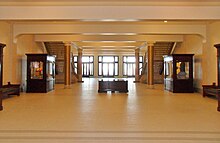
The first floor, or ground floor, was the first completed and has the least amount of decorative finish work. The exterior stairs on the east and west ends of the building lead to this level, versus the front steps which lead directly to the second floor. When first completed in 1916 the ground floor was mostly a vast, open exhibit space spanning the entire length of the building, while offices were built in the four corners of this level. The ceiling beneath the rotunda above is made of glass (which also serves as the floor above), and allows light from the 2nd floor to illuminate the ground floor also. Over time the large open areas of the ground floor were walled in and divided, extending the offices into the public space.[18] Now the ground floor still contains many of the capitol's exhibits, and includes a small visitor center and gift shop.
Second floor


The building's second floor often referred to as the main floor, has retained much of its historic appearance over the years. This floor also serves as the first level of the three-story rotunda and flanking atria. The rotunda occupies the center of the building, under the dome. The interior ceiling of the dome, which reaches 165 feet (50 m) above the floor, includes a large painting by artist William Slater. The mural includes
The dome is supported by marble covered, coffered arches, which sit on four
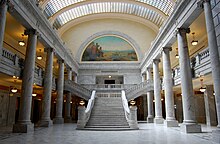
Flanking the east and west sides of the rotunda are atria, which contain large skylights, allowing sunlight to enter the public areas. Surrounding the atria are two levels of balconies which are supported by twenty-four monolithic, Ionic style columns.[18] At the end of each atrium is a marble staircase, and a mural. The arched mural on the west end, above the entrance to the House Chamber is entitled the Passing of the Wagons, while the mural at east end, above the entrance to the Supreme Court, is known as the Madonna of the Wagon. Both murals were meant as a tribute to the early pioneers, and were the first commissioned works of art in the capitol, being signed by Girard Hale and Gilbert White.[19]
The state reception room, or gold room, is also located on this floor, and is often used to entertain visiting dignitaries. The gold room gets its name from the extensive usage of gold leaf in its decoration. The ceiling contains a painting entitled Children at Play by New York artist Lewis Schettle. The majority of finishings and furniture in the room have been imported from Europe, including the Russian walnut table, and several chairs are upholstered with Queen Elizabeth's coronation fabric.[19] Just west of the gold room, is the Governor's office.
Third floor
The third floor, also known as the legislative floor, contains the chambers for both the House and Senate, along with the Supreme Court. When the building was first completed the north-east corner of this floor contained the library, which has since been relocated, and the area divided into smaller offices. The House Lounge, located directly behind the chamber, was restored to its original size and configuration, and furnished with period carpets and furniture.
The Senate chamber, which houses the
The Supreme Court chamber is located at the far east end of building. The chamber is currently only used for ceremonial purposes as the
Fourth floor
Both historically and after its renovation, the fourth floor contains the viewing galleries for both the house and senate chambers, along with several offices and committee rooms. Much of the floor is open to floors below, allowing visitors to look down on the third or second floors in several locations. When the capitol opened, this floor was also used as an art gallery, and currently it contains several small exhibits along with a statue of Philo Farnsworth, a developer of television and a Utah native.
Grounds and Capitol Complex
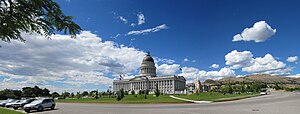
The capitol building is the centerpiece of a 40-acre (160,000 m2) plot which also includes a Vietnam War memorial, Utah Law Enforcement Memorial, and a monument dedicated to the Mormon Battalion. The renovations added a new plaza, a reflecting pool, and two office buildings, as well as underground parking.[23] The grounds feature plants, shrubs, and trees native to Utah, as well as good views of Salt Lake City, the Salt Lake Valley and the Wasatch Front.
Other buildings
State Office Building
By the 1950s, the capitol was reaching capacity and there was little room to expand offices in the building without making drastic changes to the historical layout. As a result, the state legislature appropriated $3 million (equivalent to $30.1 million in 2023[5]) to construct a new office building, located about 350 feet (110 m) directly north of the capitol. A new master plan was also created during the design process which specified creating a new plaza which would connect the two buildings and cover a new underground parking facility. The other parking lots in the complex were expanded and a maintenance shop was constructed for state vehicles. The new plan also set aside space for the construction of two more office buildings on the east and west sides of the plaza. The new building was designed by Scott & Beecher Architecture, and was smaller than the capitol building but contained much more usable working space. The finished plans were completed and presented to the state during November 1958.[3] Construction of the new building started with a groundbreaking ceremony held March 8, 1959. Because the new plan required a large amount of excavation work, the removed dirt was used to build up the ground for Interstate 15, also under construction during that period. After the building was completed, it was dedicated on June 9, 1961.[3] The building is scheduled for demolition in 2021 as it is not suitable to withstand an earthquake and the cost of demolition was lower than retrofitting the structure. The offices formerly housed in the structure began moving in January 2020 to the former American Express building in Taylorsville which was built in the 1980s. The building on 2700 West alongside Interstate 215 is adjacent to the state crime lab and the Utah Department of Transportation (UDOT) headquarters and had recently undergone interior remodeling.
House Building
Located on the west side of the capitol complex, the Rebecca D. Lockhart House Building primarily serves as the location for the large number of offices for members of the Utah House of Representatives. The lower floor of the building contains several committee rooms and the upper floor houses the Office of Legislative Research and General Counsel.
Senate Building
Located on the east side of the capitol complex, the East Senate Building holds additional offices for members of the Utah Senate. The main floor also holds The State Room, a dining room for the Capitol Café, and the second floor contains two committee rooms. Located under this building is the private lobbyist lounge, managed by the Capitol Hill Association of Lobbyists.
Artwork
Artwork on the grounds includes:
- Beehive sculptures
- Statue of Daniel C. Jackling by Avard Fairbanks
- Edward Harriman Memorial
- Statue of Thomas L. Kane by Ortho Fairbanks
- Statue of Martha Hughes Cannon by Laura Lee Stay Bradshaw
- Statue of Marriner S. Eccles by Mark DeGraffenried
- Vietnam, Cambodia, and Laos Veterans Memorial featuring a bronze statue of a soldier by Clyde Ross Morgan and a circular wall by Mark Davenport
There are 22 statues, monuments, and plaques, with spaces designated for several more.[24]
In popular culture
In
See also
- List of tallest buildings in Salt Lake City
- List of tallest domes
- Yule marble
- List of state and territorial capitols in the United States
References
- ^ a b c "National Register Information System". National Register of Historic Places. National Park Service. April 15, 2008.
- OCLC 30473917. Archived from the originalon November 1, 2013. Retrieved September 12, 2013.
- ^ a b c d e f g h i j Cooper/Rogers Architects (September 13, 2000). "Chapter II". Building & Grounds Restoration Master Plan and Historic Structures Report (PDF). Capitol Preservation Board. Retrieved September 12, 2013.
- ^ a b Ison, Yvette D. (July 1995). "Utah's First Territorial Capitol, Fillmore, Was Too Remote for Legislators". History Blazer. Utah History To Go. Archived from the original on September 14, 2017. Retrieved September 12, 2013.
- ^ Gross Domestic Product deflatorfigures follow the MeasuringWorth series.
- ^ S2CID 254448011. Retrieved September 12, 2013.
- ^ "Utah Capitol Resembling Parthenon, Will Be Built by Utah Architect". The Salt Lake Evening Telegram. March 14, 1912. Retrieved September 12, 2013 – via Utah Digital Newspapers.
- ^ "Capitol Cornerstone Will Be Laid Today". The Salt Lake Evening Telegram. April 4, 1914. Retrieved September 12, 2013 – via Utah Digital Newspapers.
- ^ Warburton, Nicole (January 3, 2008). "Capitol Redux: Historic Building's Renovation Complete". Deseret News. Retrieved September 12, 2013.
- ^ Erickson, Tiffany (August 10, 2004). "Thousands Bid Capitol Farewell Before 4-Year Renovation Starts". Deseret News. Retrieved September 12, 2013.
- ^ Nielson-Stowell, Amelia (August 1, 2004). "Designs More Inviting to Public". Deseret News. Retrieved September 12, 2013.
- ^ Genessy, Jody (August 10, 2004). "'Chain Gang' Working at the Capitol". Deseret News. Retrieved September 12, 2013.
- ^ a b Utah Division of State History. "The Utah State Capitol: Then and Now". Utah Division of State History. Archived from the original on December 3, 2010. Retrieved January 30, 2011.
- ^ ISSN 1525-0849.
- ^ "Utah State Capitol Seismic Retrofit and Restoration" (PDF). Parsons Corporation. December 2006. Retrieved September 12, 2013.
- ^ Architect of the Capitol. "The United States Capitol Dome". Architect of the Capitol. Retrieved January 27, 2011.
- ^ Gehrke, Robert (January 25, 2010). "Lobbyists Set Up in New Capitol Quarters". The Salt Lake Tribune. Retrieved December 18, 2013.
- ^ a b c d Cooper/Rogers Architects (September 13, 2000). "III". Building & Grounds Restoration Master Plan and Historic Structures Report (PDF). Capitol Preservation Board. Retrieved September 12, 2013.
- ^ a b c d e f g h State of Utah (2008). "Virtual Tour". Utah State Capitol. Retrieved February 1, 2011.
- ^ "J. R. Clancy and Oasis Stage Werks Provide Rigging Solution for Utah State Capitol Chandelier". Light and Sound America. July 9, 2008. Retrieved September 12, 2013.
- ^ U.S. Census Bureau (April 26, 2021). "Table 1. Apportionment Population and Number of Representatives by State: 2020 Census" (PDF). www.census.gov. U.S. Census Bureau. Retrieved December 12, 2022.
- ^ "About the House | Utah House of Representatives". Retrieved December 22, 2022.
- ^ Whitney, Susan (August 1, 2004). "Fixer-Upper: State Capitol Building Is Closing for 4-Year, $200 Million Renovation". Deseret News. Retrieved September 12, 2013.
- ^ "Capitol Grounds – Monuments, Memorials, Plaques" (PDF). Utah State Capitol.
External links
- Utah State Capitol (official website - link currently not working)
- 360° virtual tour

